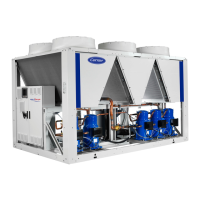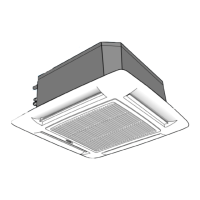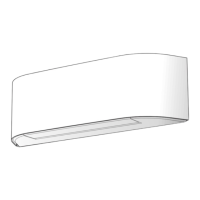
Do you have a question about the Carrier 30WG 080 and is the answer not in the manual?
| Brand | Carrier |
|---|---|
| Model | 30WG 080 |
| Category | Air Conditioner |
| Language | English |
Precautions for unit installation, damage inspection, and handling.
Safety guidelines for maintenance personnel and logbook recommendations.
Safety protocols for refrigerant circuit repairs and handling.
Inspect unit for damage, verify model, serial number, and options.
Electrical parameters like voltage, current, and power for all models.
Short-circuit current data for standard units under TN system.
Electrical data for pumps in hydronic modules, compliant with Ecodesign directive.
Table detailing compressor electrical data, usage, and current ratings.
Minimum and maximum operating limits for 61WG units.
Minimum and maximum operating limits for 30WG units.
Minimum and maximum operating limits for 30WGA units.
Anti-cavitation protection for pumps in hydronic modules.
Diagram and notes for electrical connections to the control box.
Requirements for power supply voltage and continuity.
Safety precautions and features for field control wiring.
Tables for minimum/maximum wire sections for control wiring.
Guidelines for connecting 30WGA units to remote condensers.
Procedures for refrigerant piping installation and connections.
General guidelines and limits for refrigerant pipe sizing.
Step-by-step procedure for adjusting water flow rate using control valves.
Operating principle for 61WG units with specific heating control.
Operating principle for 30WG units using drycoolers for heat rejection.
Operating principle for 30WGA units with remote air-cooled condensers.
Essential pre-start checks before unit operation.
Procedures and supervision requirements for unit start-up.
Detailed steps for adjusting refrigerant charge and subcooling.
Procedure for adjusting oil charge, especially with suction risers.
Information on hermetic scroll compressors, refrigerant type, and operating limits.
Procedures and qualifications for soldering and welding operations.
Identifying and rectifying refrigerant undercharge.
Best practices for handling refrigerants and lubricants.
Methods and precautions for detecting refrigerant leaks.
Procedures for system evacuation and vacuum levels.
Schedule for regular maintenance operations (weekly, monthly, annually).
Detailed descriptions of maintenance tasks for different service levels.
Checklist for initial equipment inspection and setup.
Checklist for unit start-up procedures including checks and voltage.












